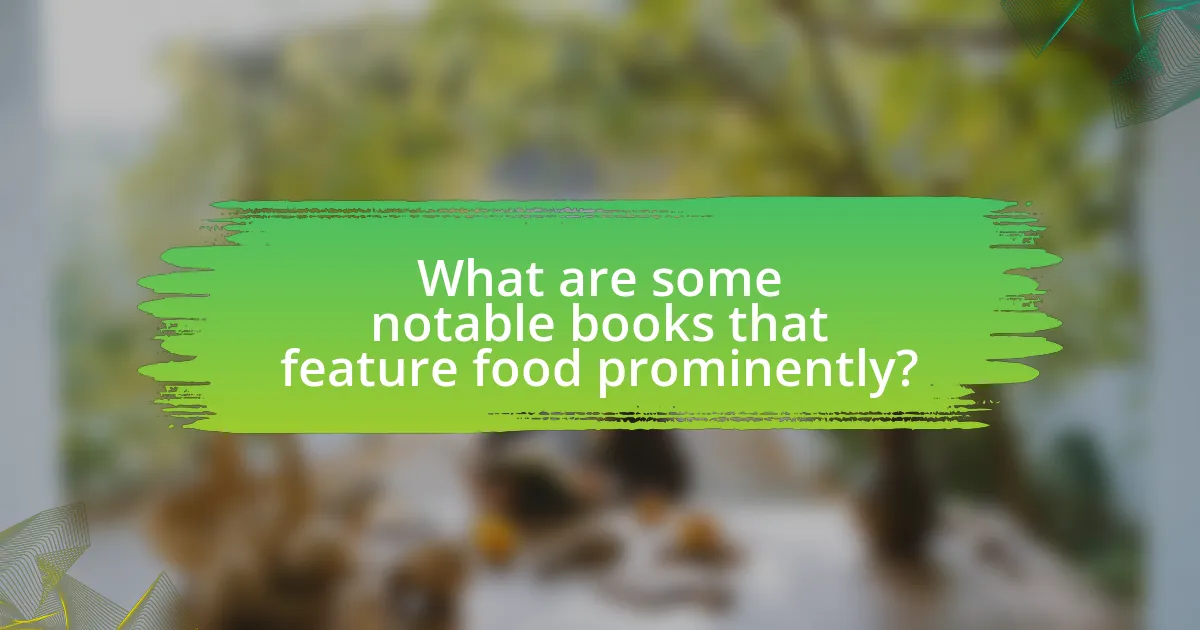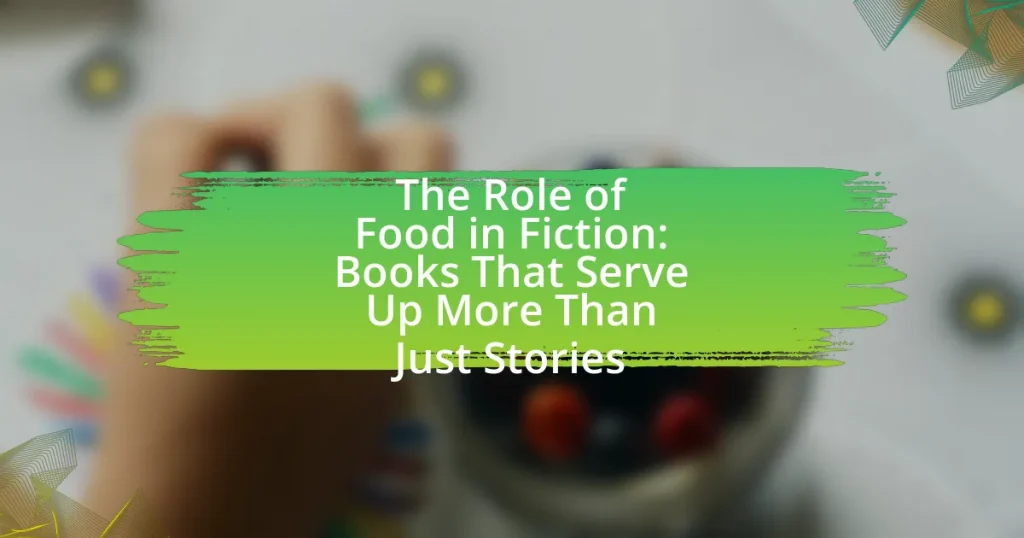The article examines the significant role of food in fiction, highlighting how it serves as a narrative device that enhances character development, cultural context, and thematic depth. It discusses various literary works, such as “Like Water for Chocolate” and “The Joy Luck Club,” illustrating how food reflects characters’ identities, emotions, and relationships. The article also explores how food symbolism enriches themes, sets the mood, and connects readers to the narrative, while providing examples of notable books and genres that prominently feature food. Additionally, it offers practical tips for readers to engage with food in literature, enhancing their overall reading experience.

What is the significance of food in fiction?
Food in fiction serves as a significant narrative device that enhances character development, cultural context, and thematic depth. It often reflects the identities and backgrounds of characters, illustrating their social status, personal relationships, and emotional states. For example, in works like “Like Water for Chocolate” by Laura Esquivel, food symbolizes love and longing, intertwining culinary practices with the characters’ emotional journeys. Additionally, food can establish a setting, providing readers with sensory details that immerse them in the story’s world, as seen in “The Joy Luck Club” by Amy Tan, where meals represent familial bonds and cultural heritage. Thus, food in fiction is not merely sustenance; it is a multifaceted element that enriches storytelling by connecting readers to the characters and their experiences.
How does food contribute to character development in literature?
Food contributes to character development in literature by revealing personal traits, cultural backgrounds, and emotional states of characters. For instance, a character’s choice of food can signify their social status, such as gourmet meals indicating wealth or simple fare suggesting modest means. Additionally, food can symbolize relationships; shared meals often illustrate intimacy or conflict between characters. In works like “Like Water for Chocolate” by Laura Esquivel, food acts as a medium for expressing emotions and desires, showcasing how culinary choices reflect the characters’ inner lives and struggles. This connection between food and character is evident in various literary contexts, reinforcing the idea that what characters eat can significantly enhance readers’ understanding of their identities and motivations.
What are some examples of characters whose identities are shaped by their relationship with food?
Examples of characters whose identities are shaped by their relationship with food include Anton Ego from “Ratatouille,” who undergoes a transformation through his experience with a simple dish that evokes childhood memories, highlighting the emotional connection between food and identity. Another example is the character of Remy, also from “Ratatouille,” whose passion for cooking defies societal expectations and showcases how food can be a means of self-expression and identity formation. Additionally, in “Like Water for Chocolate,” Tita’s emotions and life experiences are intricately tied to the food she prepares, illustrating how culinary traditions can shape personal identity and relationships. These characters demonstrate that food is not merely sustenance but a powerful element that influences identity and personal growth.
How does food reflect cultural backgrounds in fictional narratives?
Food reflects cultural backgrounds in fictional narratives by serving as a symbol of identity, tradition, and social dynamics. In literature, specific dishes and culinary practices often represent the heritage of characters, illustrating their cultural roots and values. For example, in Amy Tan’s “The Joy Luck Club,” the preparation and sharing of traditional Chinese meals highlight the generational differences and cultural connections between mothers and daughters, emphasizing the importance of food in familial relationships and cultural continuity. Additionally, food can signify social status and community, as seen in works like “Like Water for Chocolate” by Laura Esquivel, where the act of cooking intertwines with personal and political struggles, showcasing how culinary practices reflect broader societal issues. These examples demonstrate that food is not merely sustenance in fiction; it is a powerful narrative device that encapsulates cultural identity and social context.
Why is food often used as a narrative device in storytelling?
Food is often used as a narrative device in storytelling because it serves as a powerful symbol that can convey themes, emotions, and cultural contexts. In literature, food can represent identity, community, and tradition, allowing characters to connect with their heritage or with each other. For example, in works like “Like Water for Chocolate” by Laura Esquivel, food is intricately tied to the characters’ emotions and relationships, illustrating how meals can embody love, conflict, and memory. This symbolic use of food enhances the narrative by providing depth and resonance, making it a crucial element in storytelling.
How does food symbolism enhance themes in literature?
Food symbolism enhances themes in literature by providing deeper meaning and emotional resonance to characters and narratives. For instance, in “Like Water for Chocolate” by Laura Esquivel, food represents love, tradition, and the struggles of women, illustrating how culinary practices are intertwined with personal and cultural identity. This connection allows readers to engage with the themes of passion and repression on a more visceral level, as the act of cooking becomes a metaphor for the characters’ desires and conflicts. Additionally, food can signify social status, cultural heritage, or familial bonds, enriching the narrative and allowing for a multifaceted exploration of human experiences.
What role does food play in setting the mood or tone of a story?
Food plays a significant role in setting the mood or tone of a story by evoking emotions, creating atmosphere, and reflecting character development. For instance, a lavish feast can convey celebration and abundance, while a sparse meal may suggest poverty or hardship. In literature, food often symbolizes cultural identity and personal relationships, enhancing the reader’s connection to the narrative. Specific examples include the detailed descriptions of meals in works like “Like Water for Chocolate” by Laura Esquivel, where food is intertwined with passion and memory, illustrating how culinary elements can deepen emotional resonance and thematic depth in storytelling.

What are some notable books that feature food prominently?
Notable books that feature food prominently include “Like Water for Chocolate” by Laura Esquivel, which intertwines recipes with the protagonist’s emotions, and “The Joy of Cooking” by Irma S. Rombauer, a classic cookbook that has influenced American cooking since its first publication in 1931. Additionally, “Eat, Pray, Love” by Elizabeth Gilbert explores food as a means of cultural connection and personal healing during the author’s journey through Italy, India, and Indonesia. These works highlight the significance of food in shaping narratives and character development, demonstrating its role beyond mere sustenance.
Which genres utilize food as a central theme?
Genres that utilize food as a central theme include culinary fiction, romance, and memoir. Culinary fiction often revolves around chefs or cooking, showcasing the art and culture of food, as seen in works like “Like Water for Chocolate” by Laura Esquivel. Romance novels frequently incorporate food to enhance emotional connections between characters, exemplified in “The Chocolate Thief” by Laura Florand. Memoirs, particularly those focused on personal experiences with food, highlight cultural and familial ties, as illustrated in “Kitchen Confidential” by Anthony Bourdain. These genres demonstrate how food serves as a narrative device to explore relationships, culture, and identity.
How does food appear in culinary fiction versus other genres?
Food in culinary fiction serves as a central theme that drives the narrative, character development, and emotional resonance, while in other genres, food often functions as a background element or a symbol. In culinary fiction, detailed descriptions of cooking processes, ingredients, and the sensory experiences of eating create an immersive experience that reflects cultural identity and personal relationships. For example, novels like “Like Water for Chocolate” by Laura Esquivel intertwine recipes with the storyline, emphasizing how food influences emotions and relationships. In contrast, genres such as mystery or romance may mention food to set a scene or develop a character but do not explore its significance in the same depth. This distinction highlights how culinary fiction elevates food from mere sustenance to a narrative device that enriches the story.
What are some classic novels that incorporate food in significant ways?
Classic novels that incorporate food in significant ways include “Like Water for Chocolate” by Laura Esquivel, “The Joy of Cooking” by Irma S. Rombauer, and “A Moveable Feast” by Ernest Hemingway. In “Like Water for Chocolate,” food serves as a medium for expressing emotions and cultural traditions, intertwining the protagonist’s life with her family’s recipes. “The Joy of Cooking” is not just a cookbook; it reflects American culinary history and domestic life, showcasing how food preparation is integral to family and social gatherings. In “A Moveable Feast,” Hemingway captures the essence of Parisian life in the 1920s, using food to evoke nostalgia and the artistic spirit of the time. These novels highlight the profound connection between food and human experience, illustrating how culinary elements can enhance narrative depth and cultural context.
What modern books highlight the role of food in their narratives?
Modern books that highlight the role of food in their narratives include “Like Water for Chocolate” by Laura Esquivel, “The Hundred-Foot Journey” by Richard C. Morais, and “Eat, Pray, Love” by Elizabeth Gilbert. In “Like Water for Chocolate,” food serves as a medium for expressing emotions and cultural traditions, intertwining the protagonist’s life with her family’s recipes. “The Hundred-Foot Journey” explores the clash of culinary cultures and the transformative power of food in bridging divides. In “Eat, Pray, Love,” food represents personal growth and self-discovery, as the author travels through Italy, India, and Indonesia, using cuisine to connect with different aspects of life. These books demonstrate how food is not merely sustenance but a vital element in storytelling, reflecting identity, culture, and relationships.
How do contemporary authors use food to connect with readers?
Contemporary authors use food as a narrative device to evoke emotions, create cultural connections, and enhance character development. By incorporating specific dishes or culinary traditions, authors can transport readers into the characters’ worlds, making experiences relatable and vivid. For instance, in works like “Like Water for Chocolate” by Laura Esquivel, food symbolizes love and longing, illustrating how meals can reflect personal and cultural identities. This connection is further supported by research indicating that food-related themes in literature can trigger sensory memories and emotional responses, thereby deepening reader engagement.
What are some recent bestsellers that revolve around food-related themes?
Recent bestsellers that revolve around food-related themes include “The Book of Longings” by Sue Monk Kidd, which explores the life of a woman in biblical times with a strong connection to food and culture, and “The Midnight Library” by Matt Haig, where food plays a significant role in the protagonist’s exploration of life choices. Additionally, “Taste: My Life Through Food” by Stanley Tucci combines memoir and culinary experiences, highlighting the importance of food in personal narratives. These titles have gained popularity for their rich storytelling intertwined with food themes, reflecting cultural and emotional connections to cuisine.

How can readers engage with food in fiction?
Readers can engage with food in fiction by immersing themselves in the sensory experiences and cultural contexts that food represents within the narrative. This engagement allows readers to connect emotionally with characters and settings, as food often symbolizes identity, tradition, and relationships. For instance, novels like “Like Water for Chocolate” by Laura Esquivel intricately weave food into the storyline, illustrating how culinary practices reflect personal and cultural struggles. Such examples demonstrate that food in fiction serves not only as a plot device but also as a means for readers to explore deeper themes of love, loss, and community.
What are some ways to enhance the reading experience through food?
Enhancing the reading experience through food can be achieved by incorporating themed snacks, creating a sensory environment, and pairing food with the narrative. Themed snacks, such as dishes mentioned in the book, allow readers to immerse themselves in the story, making the experience more engaging. Creating a sensory environment, like setting the mood with aromas or sounds related to the book’s setting, can deepen emotional connections. Pairing food with the narrative, such as enjoying a glass of wine while reading a novel set in a vineyard, can enhance the overall enjoyment and understanding of the text. These methods leverage the connection between food and storytelling to create a richer reading experience.
How can readers create themed meals based on their favorite books?
Readers can create themed meals based on their favorite books by identifying key foods or meals mentioned in the text and then preparing those dishes. For example, if a book features a specific meal, such as the feasts in “Harry Potter,” readers can recreate those dishes using recipes inspired by the descriptions. Additionally, they can consider the cultural context of the book to select ingredients that reflect the setting, such as Italian cuisine for a book set in Italy. This approach not only enhances the reading experience but also allows readers to engage with the narrative on a sensory level, making the story more immersive.
What are some book clubs doing to incorporate food into their discussions?
Book clubs are incorporating food into their discussions by organizing themed potlucks where members bring dishes inspired by the book’s setting or characters. This practice enhances the reading experience by allowing participants to engage with the narrative on a sensory level, creating a deeper connection to the story. For example, a book set in Italy may prompt members to bring pasta dishes, while a novel featuring a bakery could inspire a selection of pastries. This approach not only fosters community but also encourages discussions about the cultural significance of food within the narrative, enriching the overall dialogue about the book.
What practical tips can readers apply when exploring food in literature?
Readers can enhance their exploration of food in literature by actively engaging with the text through sensory analysis. This involves paying attention to descriptive language that evokes taste, smell, and texture, which can deepen understanding of characters and settings. For instance, in works like “Like Water for Chocolate” by Laura Esquivel, food is intricately tied to emotions and cultural identity, illustrating how culinary details can reflect broader themes. Additionally, readers can research the cultural significance of specific dishes mentioned in the text, as this context enriches the reading experience and fosters a greater appreciation for the narrative.
How can readers identify and appreciate food symbolism in their readings?
Readers can identify and appreciate food symbolism in their readings by analyzing the context in which food is presented and its emotional or thematic significance. For instance, food often represents cultural identity, social status, or personal relationships, which can be discerned through character interactions and narrative descriptions. An example is found in works like “Like Water for Chocolate” by Laura Esquivel, where food is intricately tied to emotions and events, illustrating how meals can symbolize love, longing, and tradition. By paying attention to these elements, readers can uncover deeper meanings and connections within the text, enhancing their overall understanding and enjoyment of the story.
What resources are available for readers interested in food literature?
Readers interested in food literature can access a variety of resources, including books, journals, and online platforms dedicated to culinary narratives. Notable books such as “The Gastronomical Me” by M.F.K. Fisher and “Like Water for Chocolate” by Laura Esquivel exemplify the genre’s depth. Additionally, academic journals like “Food, Culture & Society” provide scholarly articles that explore the intersection of food and literature. Online platforms such as Goodreads and food blogs also curate lists and reviews of food literature, making it easier for readers to discover new titles and authors.






